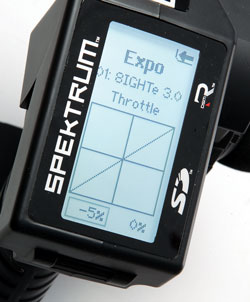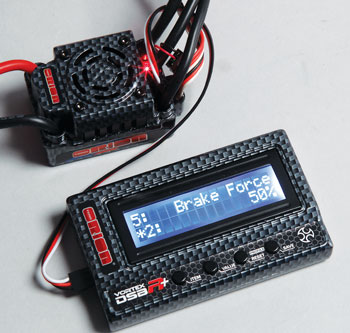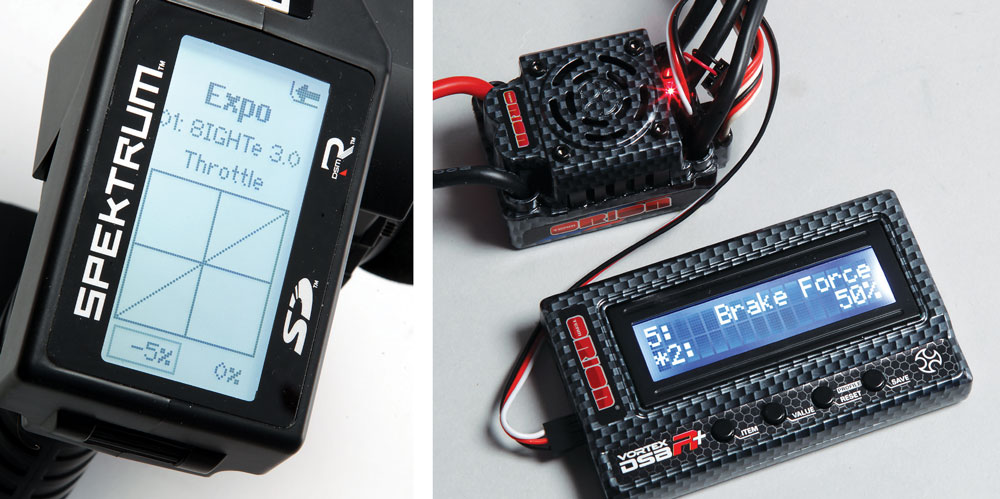Words: Charlie Suangka
Brakes are one of the more difficult areas of tuning inthe world of RC. There are multiple factors that come into play. The motor, gearing, traction and vehicle’s suspension all affect the weight transfer. It goes on and on. One thing we have instant control over is the brake settings of our ESC and transmitter. This month’s tech topic is going to take a little closer look at the brake side of our tuning.
 BAD BRAKING
BAD BRAKING
Too much brake can be a bad thing. It’s true, overpowering the brake input can cause wheel lock up or excessive heating to the ESC and motor. The heating can lead to inconsistent brakes. Sometimes they create so much heat so fast, the brakes simply always feel weak. In addition, when the brakes are too strong, you lose a very large, usable range of your brake input. This means that you have a very small amount of brakes. This makes modulating brake input, or getting that perfect feel, very hard to find. Merely lowering the brake input will increase the range of usable brake input. You may not be able to “lock ‘em up” at all speeds, but for your fine braking control and feel, the vehicle will brake better. Being able to stab the brakes hard in a panic without wheel lock can be a life-saver.
In addition to better feel and actual control, you will decrease the voltage spikes that your motor generates and tries to push into the ESC. When the motor is given high amounts of brake input from the ESC, it will have to put all the forward movement into stopping power. This causes a massive voltage spike that is absorbed by the motor and the ESC. This creates heat, creates inconsistency, and ultimately, runs the risk of damaging the motor and ESC.
BRAKE ADJUSTMENTS
What is the best way to tone down your brakes? There are differing opinions, but most medium-level and above radios have an adjustable throttle and brake output setting. The EPA setting will have a throttle and brake side. You can simply lower the brake side. Many radios also have a secondary “brake only” adjustment. The ATL, or brake setting, works in much the same way, but allows a quicker way to adjust the brakes on the fly. Often these settings are assigned to a button on the radio that allows you to dial the brakes up or down while you drive. Using a combination of both settings is ideal. Turn down your master brake EPA internally, then use your on the fly brake/ATL setting to fine-tune exactly where you need the brakes. Limiting the “maximum” brakes with the main EPA setting will prevent you from dialing in ALL the brakes bit by bit, over the course of many runs. Many speed controls have brake settings that can be adjusted in the same manner. Brake power, brake force, brake feel, overall brake, push brake, max brake and many more names have been used. Read your manual, find out what setting is the one you need, and use it. This setting can again be used in combination with the radio systems for on-the-fly adjustments.
OTHER ADJUSTMENTS
Electronic speed controls have other brake tuning options. It would be hard to encompass all the known ESC jargon and try to break them down, so the best advice is simply to try them out. Get a feel for them and test them yourself so that you know exactly what each does. The descriptions in the manual may not be enough to put what actually happens in context. Try small changes, and try full range changes. Get a feel for the reaction of the brake change at multiple speeds. High speed, low speed and medium speed response is often effected by various ESC magic; sometimes not equally. Be sure you’re getting a good idea of each range of braking speed response as you test.
 MOTOR VARIABLES
MOTOR VARIABLES
It seems strange that less brake would mean more brake, but it’s true. In cases when full brakes still do not feel strong enough, you may want to look into the specifics and make some changes. Higher turn and spec turn racing generally find the gearing to be overly tall. Tall gearing also affects the brakes adversely. Add to this that high turn motors usually do not have strong braking characteristics and you will often find mush brakes. Lowering the overall brake input in these cases can do wonders for helping temps. The motor is “always” being asked for more braking then it can supply and seems to rarely have enough braking power. This generates an enormous amount of heat very quickly. A few panic brake maneuvers can spike temps in a hurry. Reducing the overall brakes won’t affect overall braking power, but will help to reduce temps.
WRAP UP
In the end, brakes are very specific to the driver and often, something many overlook. Getting around the track faster, and being able to have control of your rig in go-fast situations is never a bad thing. Find some time, do some brake testing, and reap the benefits!
 RC Driver The Best In RC Car & Truck News, Reviews & Video
RC Driver The Best In RC Car & Truck News, Reviews & Video 









I was reading about what u were writing about brakes I do beleive what u said is right. I actually was driving my Rc8.2e and hit the breaks at such ahigh speed my pinion gear came off luckily i was able to fix it. Anyhow I just got a Kyosho Inferno mp9 tki3 and brakes on a nitro vehicle are much more different compared too electric i would definately read if you wrote about braking system on a nitro buggy. Thanks Bill Curtis